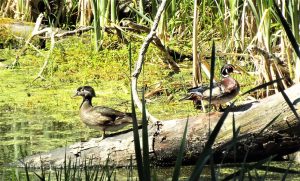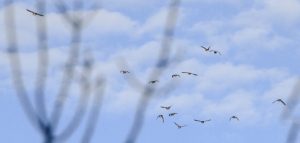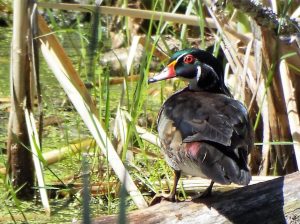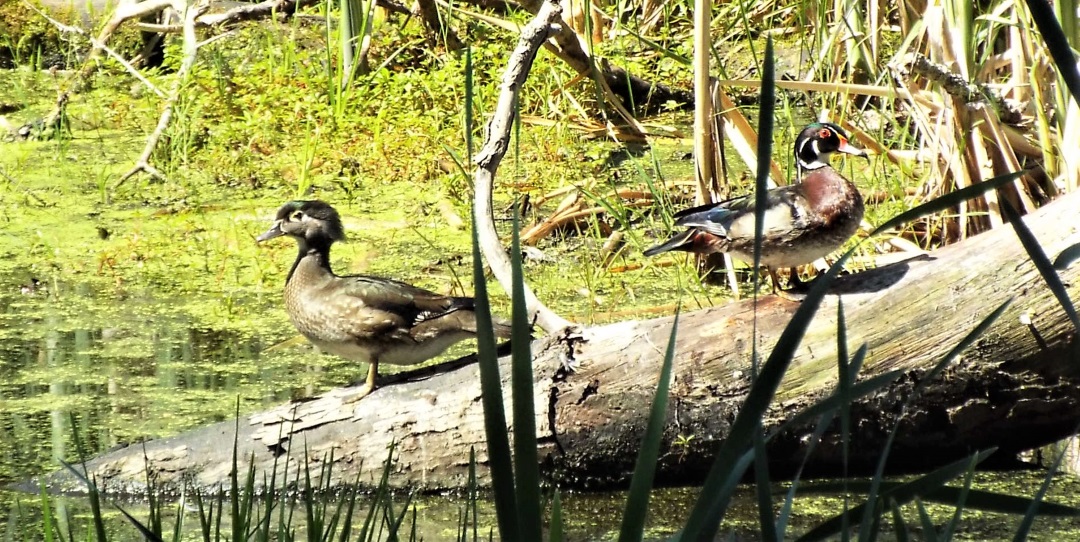Water Closet for March 31, 2017
The other morning Middleton Stream Teamers while spring cleaning the park at Farnsworth Landing on the Ipswich River compared notes on Aix sponsa, wood ducks, recently seen. We agreed that there has been an increase of this species in the last couple decades.
Sometimes on a paddle down river we’ll scare up several while rounding each of its many meanders. [pullquote]”See the mating pair on the dark and shaded flood of a little woodland river; they seem to float as lightly as the drifting leaves”[/pullquote]
This discussion led one member to the Closet’s treasured volumes by ornithologist extraordinaire Edward Howe Forbush. A century ago he gave us three thick books, entitled Birds of Massachusetts and other New England States. This monumental work was published by the Commonwealth of Massachusetts in 1925. We have a set in the Closet thanks to Francis Masse who passed on this gift from his father, the late Chester Masse, who served the area as a state game warden.
We can’t resist starting with an old fashioned bit of what some would call Victorian purple prose. Flashes are found throughout Forbush’s pages between more objective passages and anecdotes. Authors then didn’t have the media we have, illustrations in books at the time were black and white photos, ink sketches and a few expensive colored plates of paintings, hence the need for word pictures. Here is Forbush peeking from a riverside hiding place:
“See the mating pair on the dark and shaded flood of a little woodland river; they seem to float as lightly as the drifting leaves. The male glides along proudly, his head ruffled and his crest distended, his scapular feathers raised and lowered at will, while his plumes flash with metallic luster whenever the sun’s rays sifting through the foliage intercept his course. She coyly retires; he daintily follows, exhibiting all his graces, the darkling colors of his plumage relieved by the pure white markings of head and breast and the bright red of feet and bill and large lustrous eye. What a picture they make, as, intent on one another, they glide along close together, she clothed in modest hues, he glowing and resplendent.

Pair of wood ducks molting. This difficult to obtain close up photo was taking in late August 2016 on the beaver impoundment just southwest of Middleton Pond. – Donna Bambury photo
He nods and calls in low sweet tender tones and thus, she leading, he pursuing, they disappear into the shadows where the stream turns upon another course.”
Wow! Maybe we should end here and leave them to imagined bliss.
The courting Forbush so delightfully and anthropomorphically described may lead to a snug high-rise apartment with the female sitting on 15 eggs. Wood ducks are cavity nesters. We wonder if the increase in wood ducks isn’t due to an increase of holes in trees. In the last half century there has been a significant increase in protected forests and less cutting in others. The trees are getting older hence more holes. Also people like Middleton’s Red Caulfield have put up wood duck boxes. Along our rivers and streams since their return two decades ago beavers have been drowning many acres of trees. The upright corpses attract wood peckers, insects, and fungi, hence in time more hide-a-ways. Then there is the change in people’s behavior so vividly remembered by old timers who lived in rural areas. Just 70 years ago there were shotguns and twenty-twos, often loaded, in barns, workshops and farmhouse entryways. To some any wild thing that moved was fair game. Most hawks and owls were deemed chicken killers. Ducks were shot and eaten. Other animals, even small birds were practice targets. Another 60 years before those waning agrarian years, the hunting of birds occurred on a massive scale along our coast by market hunters. The “good old days,” so nostalgically remembered by many old timers were bad ones for wild creatures. According to Forbush, wood ducks in the mid-19th century darkened the skies at times and by the end of the nineteenth century were almost extinct. European poultry fanciers were sending wood ducks raised there back to the states from whence their ancestors came. The good news is they are coming back in the wild. Jim Berry Ipswich ornithologist, who has been working with colleagues throughout the state on the Massachusetts Audubon Bird Breeding Atlas, reports that wood ducks were reported in 377 of 1077 area blocks inventoried three decades ago in Atlas issue 1. Atlas 2, 2012, has them in 664 of the 1077 blocks. Jim warns us to take these numbers with a grain of salt. The inventories for Atlas 2 have been more intensive, the areas better covered. However, he a life-long North Shore birder, agrees with us Stream Teamers that there are more of these very beautiful-dabbler ducks that are roughly half the weight of common mallards, also dabblers.

Wood ducks just spooked while swimming on open water, Boston Brook, Middleton. On ascnding they make squeaking sound unlike the quacks of mallard. Yearly in the past more wood ducks have been seen and heard in the area. – Judy Schneider photo
One old Stream Teamer reports seeing more wood ducks each passing spring. This March 2017 he spooked 70 in scattered small groups in a half hour’s hike along Boston Brook in Middleton.
We digressed above and left the developing embryos in the tree cavity under mother where they will be for four weeks until hatching. They’ll then hang out in their protective apartment fasting for a day before venturing forth in the open air dressed in light down. Now observations become dicey. John James Audubon observed a brood jumping from a high exit hole to water far below. Their mother rounded them up and then led them on a much longer more dangerous adventure through to fledging. Other observers have seen them with their sharp claws and a bill tip, called a nail, climbing down trunks to ground and water. Still others say they’ve seen mothers carrying them one by one to the water where they’ll feed until fledging if the snapping turtles, large fish and snakes don’t get them first. Life for young ducklings and goslings is precarious.
The Closet’s small copy of Audubon’s famous elephant portfolio is open now to his wood duck painting.

Male wood duck in early stages of molting below the heron rookery near Middleton Pond. – Donna Bambury photo
Audubon, without camera, shot his subjects with gun and then wired them into dramatic poses. Here before us are two “glowing and resplendent” males and two females “clothed in modest hues.” One of the females is looking out from a hollow tree.
A few years ago stream teamer Glenice Kelley, while spring cleaning at Farnsworth Landing, accidentally touched with rake a well hidden female mallard, distant relative of the wood duck. She was incubating a dozen eggs in a ground nest. Mother mallard moved, hence was revealed. We’ve returned several times since to peer in at her on a nest among the leaves at the base of a red cedar just twenty feet from major highway Route 114. She sometimes has her wings spread over the sides of her nest, feathers somewhat extended, almost a perfect match for the brown oak leaves. May her brood and those of all ducks survive to be led by mothers to water and then on to fledging and flight. We can only wish; predators will determine.
* Essay was frist published in April 2011. This is a March 2017 revision. Wood ducks are back here in numbers again this spring. Each year we see more.
__________________________________________________________
WATER RESOURCE AND CONSERVATION INFORMATION
FOR MIDDLETON, BOXFORD AND TOPSFIELD
| Precipitation Data* for Month of: | Dec | Jan | Feb | March | |
| 30 Year Normal (1981 – 2010) Inches | 4.12 | 3.40 | 3.25 | 4.65 | |
| 2016/2017 Central Watershed Actual | 4.41 | 4.02 | 3.46 | 1.5** as of March 24 | |
Ipswich R. Flow Rate (S. Middleton USGS Gage) in Cubic Feet/ Second (CFS):
For March 24, 2017 Normal . . . 189 CFS Current Rate . . . 78.2 CFS
*Danvers Water Filtration Plant, Lake Street, Middleton is the source for actual precipitation data thru Feb.
**Middleton Stream Team is source of actual precipitation data for March.
Normals data is from the National Climatic Data Center.
THE WATER CLOSET is provided by the Middleton Stream Team: www.middletonstreamteam.org or <MSTMiddletonMA@gmail.com>


saladin hello my website is saladin
bisabet hello my website is bisabet
j3 4d hello my website is j3 4d
ggi-idn hello my website is ggi-idn
shrot hello my website is shrot
tokyo88 hello my website is tokyo88
molo đỏ hello my website is molo đỏ
ion-item hello my website is ion-item
js加固 hello my website is js加固
A lovely romantic and colorful courtship, as only Pike can describe. Thanks for the memory of the duck find during our clean-up at Farnsworth landing a few years ago. There are always nature’s gifts awaiting us.